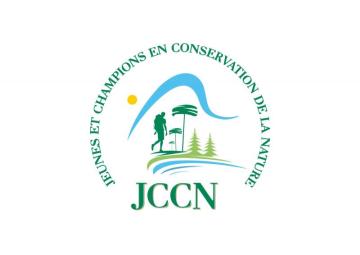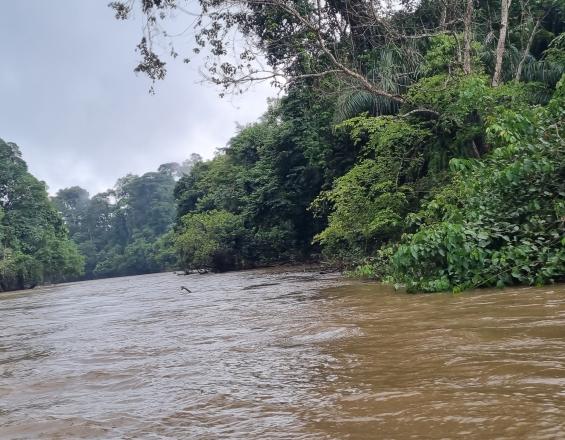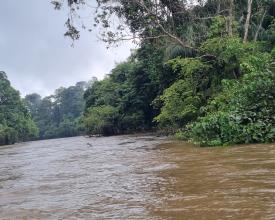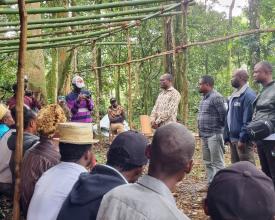
Conservación de la biodiversidad por los pueblos indígenas en el APAC Kisimbosa-Chamakasa

Kisimbosa-Chamakasa es una de las principales APAC apoyadas por ANAPAC en la RDC con vistas a conservar la biodiversidad y los ecosistemas naturales mediante métodos y prácticas tradicionales, y preservar los valores culturales y espirituales. El APAC de Kisimbosa-Chamakasa, asegurado por tierras en régimen de CFCL, está situado en la agrupación de Bakano, en el territorio de Walikale, en la provincia de Kivu Norte. Con una superficie total de 5.572,57 hectáreas, este territorio perteneciente a los pueblos indígenas pigmeos obtuvo el estatus de concesión forestal comunitaria local (CFCL) por una orden del gobernador provincial que asignaba una concesión forestal a la comunidad local Bambuti Babuluko en el sector Bakano del territorio Walikale. Kisimbosa-Chamakasa contribuye así de forma importante a la conservación in situ de la biodiversidad mediante el uso tradicional de los recursos naturales basado en normas y prácticas consuetudinarias.
Contexto
Défis à relever
Las normas y prácticas observadas en el APAC Kisimbosa-Chamakasa permiten hacer frente a varios retos. En el plano medioambiental, cabe señalar que la zona se enfrenta a la entrada incontrolada de miembros de las comunidades vecinas con fines de caza y pesca, lo que supone una carga para los recursos de fauna y pesca; al incumplimiento de las normas de caza y pesca por parte de algunos miembros de la comunidad, y al uso de equipos de pesca inadecuados, sobre todo mosquiteras importadas. Regular el uso de los recursos de forma tradicional y garantizar que todos tengan acceso a los diversos beneficios asociados a la gestión del lugar contribuye enormemente a mejorar el tejido socioeconómico de las poblaciones indígenas y locales.
Ubicación
Procesar
Resumen del proceso
El sencillo plan de gestión ha permitido establecer los métodos tradicionales de uso de la tierra y extracción de recursos. Las actividades se planifican y las decisiones importantes sobre el uso de la tierra y la gestión de los recursos se toman en una asamblea comunitaria a la que asisten representantes de todas las familias titulares de derechos sobre la tierra.
Bloques de construcción
Asegurar la tenencia de la tierra en el emplazamiento obteniendo el estatus de CFCL
Con el fin de asegurar la tenencia de la tierra, el sitio de Kisimbosa-Chamakasa recibió el estatus de concesión forestal comunitaria local (CFCL) mediante la Orden del Gobernador N°01/223/CAB/GP-NK/2019 del 11 de abril de 2019 que asigna una concesión forestal a la comunidad local de Bambuti Babuluko en el sector de Bakano, en el territorio de Walikale.
Factores facilitadores
El uso de la tierra y los métodos de extracción de recursos son tradicionales y están definidos en el sencillo plan de gestión del lugar. Las escasas disputas relacionadas con la gestión del sitio o el acceso a los recursos son gestionadas dentro de la Barza por el colegio de ancianos consuetudinarios, que están facultados para aplicar sanciones consuetudinarias. El comité de gestión local y el comité de seguimiento y evaluación se encargan de la gestión y el seguimiento cotidianos del yacimiento.
Lección aprendida
Al obtener el estatus de concesión forestal comunitaria local (CFCL), APAC ha podido asegurarse la tenencia de la tierra.
Organización de ferias culturales y asambleas comunitarias
Como zona de patrimonio indígena y comunitario, Kisimbosa-Chamakasa se beneficia de una forma de gobernanza a cargo de los pueblos indígenas y las comunidades locales, de manera inclusiva y tradicional. Periódicamente se organizan ballets y ferias culturales para mostrar obras de arte, danzas tradicionales, etc. La comunidad también cuenta con un museo para conservar los valores culturales y programas para transmitir los conocimientos culturales a las generaciones más jóvenes (programa Niño-Naturaleza), etc.
Factores facilitadores
A través de estas ferias culturales, los miembros de la comunidad promueven los principales atributos culturales presentes en la zona de Kisimbosa-Chamakasa. Estos atributos incluyen montañas, arroyos y árboles sagrados. Los valores culturales y espirituales de la naturaleza en torno a los distintos atributos incluyen la circuncisión tradicional de los jóvenes varones en zonas reservadas a tal efecto, la comunión periódica con los antepasados, ritos tradicionales y danzas culturales, etc.
Lección aprendida
La organización de ferias culturales contribuye a promover los valores culturales y espirituales de la zona.
Impactos
La gestión tradicional del yacimiento de Kisimbosa-Chamakasa aporta una serie de beneficios a las comunidades locales e indígenas. En el marco del reparto justo y equitativo de los beneficios, el acceso a los recursos se concede de forma tradicional y familiar. Además del acceso a los recursos naturales, los miembros de la comunidad se benefician de otras ventajas como la escolarización de sus hijos, gracias al apoyo prestado por los socios locales de desarrollo, y la representación del yacimiento en diversos foros comunitarios. Las decisiones relativas a los distintos beneficiarios son tomadas por los miembros de la comunidad representados en los órganos de gestión del sitio. Los titulares de los derechos participan activamente en todas las decisiones. Se trata de decisiones como las relativas a la gestión y planificación de las actividades a nivel del sitio, las relativas a la sucesión y sustitución en los órganos de gestión, etc.
Beneficiarios
El método de gestión aplicado al yacimiento beneficia a varios tipos de partes interesadas, como miembros de comunidades indígenas y locales, socios técnicos y financieros, investigadores, miembros de la sociedad civil, etc.
Objetivos de Desarrollo Sostenible
Historia
Kisimbosa-Chamakasa es una de las principales zonas de vida y territorios de Pueblos Indígenas y Comunidades Locales (APAC) apoyados por ANAPAC, con vistas a conservar la biodiversidad y los ecosistemas naturales mediante métodos y prácticas tradicionales, y preservar los valores culturales y espirituales. La APAC Kisimbosa-Chamakasa, asegurada por tierras en régimen de CFCL, está situada en la agrupación Bakano, en el territorio de Walikale, en la provincia de Kivu Norte. Con una superficie total de 5572,57 ha, este territorio de pueblos indígenas pigmeos obtuvo el estatus CFCL con el apoyo de la organización PIDEP y el Réseau CREF, mediante la Orden del Gobernador N°01/223/CAB/GP-NK/2019 de 11 de abril de 2019 que asigna una concesión forestal a la comunidad local Bambuti Babuluko en el sector Bakano, en el territorio Walikale. La concesión forestal de la comunidad local Bambuti Babuluko, denominada KISIMBOSA CHAMAKASA, fue asignada a los Bambuti Babuluko a través de sus representantes designados consuetudinariamente en el marco de la ejecución del proyecto de promoción de los Bosques Comunitarios en la RDC.
La mayor parte de la zona de Kisimbosa está constituida por bosques primarios de secano y bosques establecidos en suelos hidromorfos, que albergan bosques pantanosos atravesados por pequeños o grandes ríos. Situada en la cuenca central congoleña, la vegetación del Kisimbosa se caracteriza por densos bosques pluviales perennifolios típicos de la zona tropical húmeda, con especies como Cynometra hankei, Pycnanthus angolens, Entandrophragma angolense, Afzelia bella, Maesopsis eminii, Ricinodendron heudelotii, etc. (informe del inventario del CFCL Kisimbosa-Chamakasa). En su configuración actual, el CFCL Kisimbosa-Chamakasa está drenado por varios ríos, entre ellos el Luhoo y parte del Nyanzila. El Luhoo desemboca en el Lowa, afluente del Congo. Los caladeros del interior están formados principalmente por pequeños ríos, como Lupupu, Idambo, Makwangwala, Nguba, Bilelelele, Namakwa, etc. Los humedales y pantanos también abundan en recursos clave. Entre las especies animales que se encuentran en la zona cubierta por el CFCL de Kisimbosa figuran el leopardo, el chimpancé, el antílope negro, la gacela, el mono, el babuino y el puercoespín.





